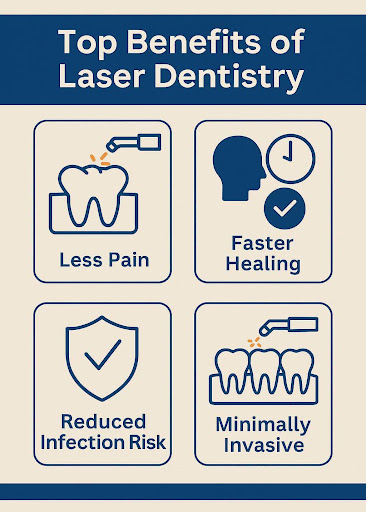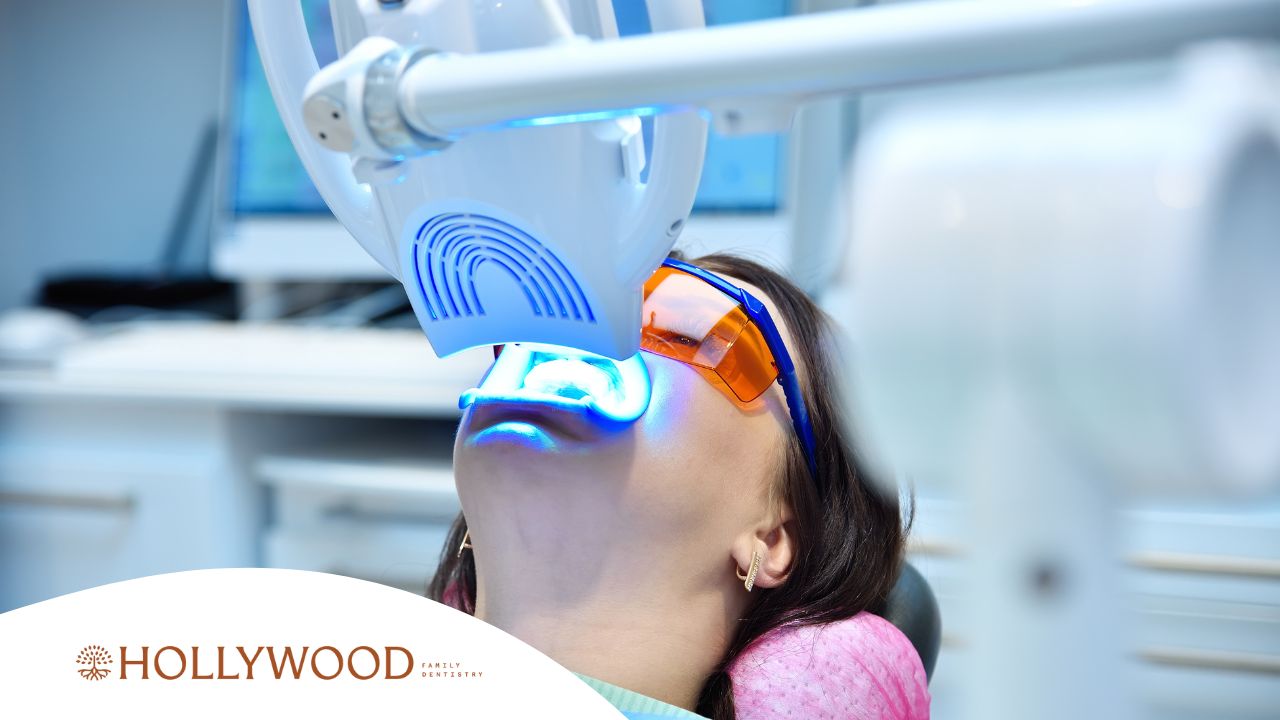Laser dentistry revolutionizes dental care by reducing pain, minimizing bleeding, and speeding up recovery times. Benefits of laser dentistry include enhanced precision in procedures, reduced risk of infection due to less tissue damage, and quicker healing times. This innovative technique, which emerged in the 1990s, provides a better way to perform dental procedures and often eliminates the need for local anesthesia. Our practice has witnessed how laser treatments create a comfortable experience for patients who feel anxious about dental visits.
Dental laser treatment uses FDA-approved technology that delivers concentrated light beams to treat oral tissues with precision. Laser dentistry’s benefits go beyond patient comfort—the treatments cause less swelling than conventional dental tools. The technology can detect cavities early, eliminate bacteria during procedures, and seal tubules on the tooth’s root, which promotes long-term dental health.
This piece explores the many advantages and applications of dental lasers, from basic cleaning and reshaping to treating gum disease and whitening teeth. You’ll learn about the pros and cons of laser dentistry to determine if this modern approach suits your dental needs. Patients who avoid dental work because of anxiety or pain concerns might find laser dentistry to be their ideal solution.
What is Laser Dentistry and How Does It Work?
LASER means “Light Amplification by Stimulated Emission of Radiation,” and dentists started using it in 1994. These dental lasers emit concentrated light energy beams that create specific reactions in oral tissues. The target tissues absorb this light energy and convert it to heat, which lets dentists cut, reshape, or remove tissue with precision.
Fundamental Laser-Tissue Interactions
Oral tissues react to laser energy in four distinct ways:
- Absorption – This vital interaction happens when specific molecules (chromophores) absorb photons and turn light energy into heat
- Reflection – Light simply bounces off the tissue surface
- Transmission – Light moves through tissue and affects deeper layers
- Scattering – Light spreads in multiple directions within the tissue
We classify dental lasers into two main categories based on how they work with different tissues:
Hard tissue lasers cut through tooth structure and bone. Water and specific tooth minerals absorb their wavelengths. Erbium lasers (Er:YAG and Er,Cr: YSGG) work well on dental hard tissues because they have a strong attraction to hydroxyapatite and water.
Soft tissue lasers work on gums and other soft oral tissues. These include diode lasers (wavelengths 810-980 nm) that target tissue pigment and hemoglobin. CO₂ lasers (10,600 nm wavelength) excel at soft tissue procedures because water absorbs them well.
Successful laser dentistry matches specific wavelengths to chromophores in target tissues. To cite an instance, dark pigment and hemoglobin in inflamed tissues readily absorb visible and near-infrared wavelengths. Healthy tissue with minimal pigmentation responds better to wavelengths that water absorbs well.
Tissue responds differently to laser heat at various temperatures. Below 50°C causes hyperthermia, around 60°C leads to protein denaturation, 100°C results in vaporization, and temperatures above 200°C cause carbonization. Dentists control these reactions carefully to achieve the best treatment results.
Top Benefits of Laser Dentistry

Modern dental technology has revolutionized traditional methods through laser dentistry. Patients now enjoy better comfort and amazing benefits during their dental visits.
Minimized Pain and Discomfort
Dental laser treatment’s biggest advantage is how much it reduces pain. Dentists can perform many procedures with minimal or no anesthesia. This helps nervous patients feel more at ease. The laser’s precise nature seals nerve endings during procedures, so patients feel less discomfort both during and after treatment.
Reduced Bleeding and Swelling
Laser dentistry cuts down bleeding by a lot through instant coagulation. The laser’s heat seals blood vessels as it works. Dentists get a clearer view and can perform cleaner procedures. Patients also experience much less swelling after their treatment, which makes recovery easier.
Faster Healing and Recovery
Patients heal much quicker after laser procedures compared to old-school methods. Most people can get back to their routine within 24 hours, unlike traditional surgeries that need 2-4 weeks. Healing happens faster because lasers boost tissue regeneration and barely disturb nearby areas.
Decreased Risk of Infection
Lasers’ sterilizing ability adds another great benefit. These tools kill 99.9% of bacteria on contact. The treated areas become more sterile, which lowers infection risks. This germ-killing effect helps clean the treated spots and leads to better healing.
Precision and Preservation of Healthy Tissue
Dentists achieve unmatched accuracy with laser technology. They can work on specific spots without hurting the healthy tissue around them. Your natural tooth structure stays more intact. This precision really helps especially when treating dental caries while saving healthy dental tissue.
| Traditional Dentistry | Laser Dentistry |
| Often requires anesthesia | Frequently performed without anesthesia |
| More bleeding and swelling | Minimized bleeding and swelling |
| Longer recovery periods | Significantly faster healing |
| Higher infection risk | Reduced infection risk through sterilization |
| May damage surrounding tissue | Preserves healthy tissue |
Common Uses of Laser Dentistry in Modern Clinics
Modern dental clinics now use laser technology in many procedures. This new approach has changed how patients experience dental work. Dental lasers have become vital tools that dentists use every day.
Soft Tissue Procedures
Lasers work with amazing precision to treat gum conditions. Periodontal therapies work better with lasers because they target diseased tissue and leave healthy areas untouched. Patients with “gummy smiles” can benefit from laser gum contouring that creates balanced tooth-to-gum ratios without using traditional scalpels.
Laser technology has changed how dentists perform frenectomies—procedures that free restrictive tissue folds in the mouth. The CO2 laser needs just less than 10 seconds to complete these procedures. Patients feel less pain in the first week compared to traditional scalpel frenectomies.
Hard Tissue Applications
Cavity detection and treatment have improved with laser technology. Systems like DEXIS CariVu™ can find decay hidden beneath the tooth surface that digital X-rays might miss. These laser cavity detection systems are highly reliable with 90% accuracy in finding tooth decay.
Er:YAG and Er,Cr:YSGG lasers remove cavities with precision and minimal heat damage. Patients often don’t need anesthesia or traditional drills.
Therapeutic Uses
Laser treatment of cold sores stands out as a remarkable application. Catching the problem early at the tingling stage lets laser therapy prevent a full outbreak. The treatment kills the responsible virus and brings relief within minutes.
| Procedure | Traditional Method | Laser Approach | Primary Benefit |
| Cavity Detection | Visual exam/X-rays | Laser transillumination | Earlier detection |
| Gum Disease | Scaling and planing | LANAP procedure | Less invasive with faster healing |
| Cold Sore Treatment | Topical medications | Laser therapy | Prevention of full outbreak |
| Frenectomy | Scalpel and sutures | Laser excision | Completed in seconds with minimal bleeding |
Cosmetic Applications
Laser technology makes teeth whitening better by activating peroxide-bleach whitening agents. Studies show Epic dental lasers can achieve 6-12 shade improvements in just 20 minutes of gel-to-tooth contact time.
Want to learn how laser dentistry could make your dental visits better? Reach out to our office to see which laser treatments match your dental needs
Conclusion : The Future of Dental Care is Here
After learning about laser dentistry’s remarkable benefits, we can see why this technology has reshaped modern dental practices. Without doubt, laser treatments give patients a gentler alternative to traditional methods and deliver exceptional results. Laser dentistry started in the 1990s and has improved by a lot. It now handles everything from routine cleanings to complex periodontal treatments with unmatched precision.
The advantages are clear. Patients feel less pain, bleed less, and recover faster. The lasers’ antimicrobial properties create a sterile environment that reduces infection risks during and after procedures. This technology offers a breakthrough solution for people with dental anxiety. It makes the work to be done nowhere near as intimidating as traditional methods.
Laser dentistry shows its true value in both cosmetic and therapeutic uses. The treatment gives better results with fewer side effects when treating gum disease, reshaping tissue, removing cold sores, or improving teeth whitening. Your natural tooth structure stays intact during treatments because healthy tissue is preserved.
At Hollywood Family Dentistry, we believe everyone should have access to these advanced treatment options. We invite you to contact our office today to schedule a consultation and find how laser dentistry can improve your dental experience. Our team will answer your questions and help you choose the laser treatments that match your oral health needs.
Read More on
Having Bad Breath Even After Brushing – What to Do About It
How Much Do Veneers Cost in Oregon?
Contact Us On
Call us at +1 503-281-9612
Visit us at 1735 NE 40th Ave, Portland, OR
Google Pin: https://tinyurl.com/cosmetic-dentist-in-portland
If you’re looking for a trusted cosmetic dentist in Portland, OR, Hollywood Family Dentistry offers expert care and stunning smile transformations.

